SANARY-SUR-MER, FRANCE - If it weren’t for my favourite dystopian novel, I wouldn’t be here, in this picturesque town, gazing out at a perfect scoop of a harbour, where fishing boats and pleasure craft jostle for room. This is the French seaside as it used to be: pastel buildings, palm trees, port-side cafés; fresh fish and “croustades” the local specialties. Sea and sky are the intense blue that gives the Cote d’Azur its name.
The fact that Aldous Huxley was living here when he wrote Brave New World had long intrigued me. So I departed from my Riviera itinerary, thinking, “Maybe I can find his house.”
At the train station in Toulon, I jokingly told a young American I was here for research.
“Marine biology?”
Good guess. Famed oceanographer Jacques Cousteau owned a villa in Sanary-sur-Mer, testing diving equipment in the blue Mediterranean.
“No,” I laughed, “more like human biology.”
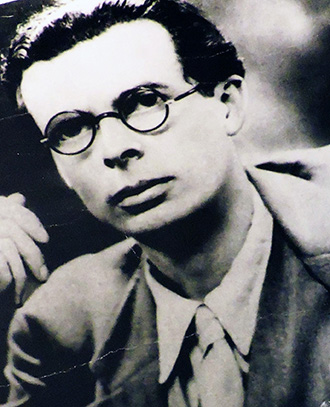
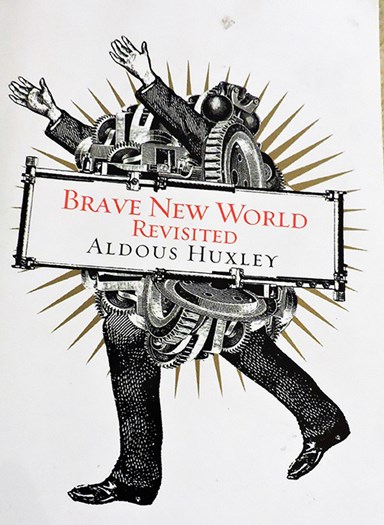
Above: Aldous Huxley was living in France when he wrote Brave New World.
During seven weeks in the summer of 1931, in a villa overlooking the beach at La Gorguette, Huxley penned a shocking vision of a future where test-tube babies are mass produced, like cars. The tale cemented his reputation as a modern-day seer. Some folks are still trying to get it banned.
This much I know: In 1930, Aldous Huxley and his wife, Maria, cruised into Sanary (“sur-mer” was added later in a bid for tourism) in their scarlet Bugatti, a custom-made two-seater with dove-grey interior. They fell in love with this Provençal village and stayed for seven years, returning again in the late ’40s. Sanary was the closest thing to permanence the nomadic pair ever knew.
At breakfast, my friendly server at the Hotel de la Tour brings croissants, excellent coffee, fresh-squeezed juice, a baguette with butter and jam and apricot cake. I devour the lot, mesmerized by stunning harbour views.
At the year-round morning market, I discover a cornucopia of local fruits and vegetables — figs, fresh almonds, apricots, tomatoes.
Why am I here, again? Oh yes, Huxley’s house — his letters all say it’s located at “La Gorguette,” the beach on the road to Bandol. Lacking an exact address, I rely on biographer and friend Sybille Bedford, a teenaged Sanary neighbour, who describes a kind of paradise: “a white-washed and green-shuttered” villa with “no entrance hall. There one supposedly walked in sandy feet, rain or shine, dinners of “delicious fried rabbit and zucchini flowers” were served, and picnics were held under eucalyptus trees.
So I rent a bike and pedal off toward La Gorguette.
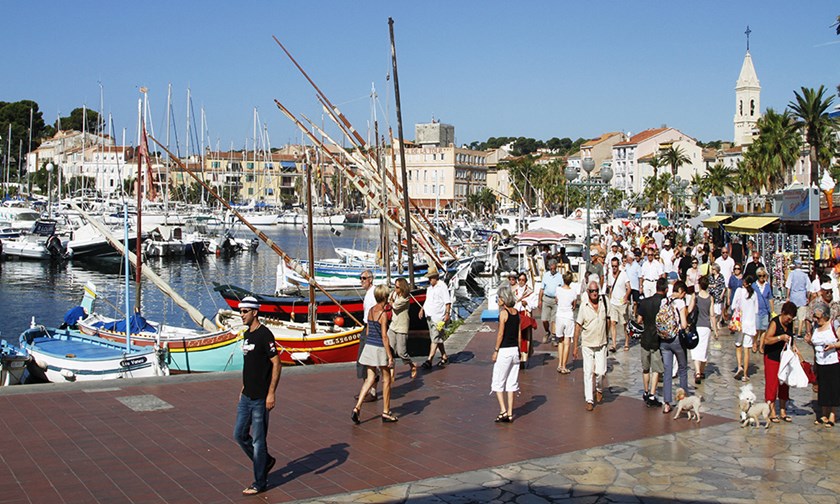
Above: The Cote d’Azur town is a popular tourist destination.
“A helmet?” I inquire hopefully of the woman behind the counter.
“Pas nécessaire en France,” she beams in response, handing me a straw boater instead, for the sun, perhaps. After all, it’s just 20 minutes away.
Pumping up and down the hilly seaside road, I first arrive at Plage de Portissol, a beauty of a turquoise beach, curled below some high cliffs, the surf white where rocks line the shore. Pressing onward, I pass French “camping” grounds, then come to Plage de Beausecours. Above this beach, long picnic tables are placed under piney woods; folks are playing pétanques. (On the way back, I’ll hear accordion music at this spot; see couples dancing and families dining at the long tables, while children play at their feet.)
Ninety minutes from town and one stop for water later, I park my bike, sinking gratefully onto a shaded bench above the sandy beach at La Gorguette. A sprite-like Frenchwoman, clad in high-heeled sneakers and silver shorts, appears as if by magic. She smiles. We remark on the weather, specifically the day’s strong wind — a boon for the many windsurfers drawn to this stretch of coast.Unpacking the gourmet treats I picked up at the market earlier, I picnic under the trees, listening to excited children on the beach below, their voices rising and falling with each gust of wind. More than 80 years ago, on just such a June day, an unusually tall, bespectacled 36-year-old Englishman was typing nearby, imagining a future that eerily resembles our present.
Art and God were dead; giant corporations ruled the world; pharmaceuticals were eaten like candy; promiscuity and shopping were virtues. Ironically, while living his own Riviera “vie en rose,” Huxley penned his futuristic nightmare. But where, exactly? I’ve found the beach, smelled the same eucalyptus-scented air. There are roughly three candidates for his green-shuttered villa. (The following day, a kind amateur historian will drive me back here, pointing out the “Huxley villa.” He was wrong, it turns out — a modern researcher later informs me most of the original villa was torn down after the war.)
Pedalling back to town, my Miss Marple get-up attracts some stares. “C’est dur, non?” sympathizes the bike lady. These hills are hard, but what a lovely adventure!
Enchanting coves, pine-shaded camp grounds, a mystery villa. Wandering about the cobblestoned streets, I come across a gilded carousel, organ music blasting away, children sitting astride fantastic beasts.
In the harbour, fishermen have returned in their wooden pointus, their handwritten signs advertise the day’s catch. In this hidden Riviera gem, local traditions endure. The high summer festival honours St. Pierre des Pecheurs (St. Peter of the Fishermen) and in late April-early May, Sanary turns pink for Just Rosé, a wine festival that attracted 40,000 visitors this spring.
Marveling at the 13th-century Romanesque tower for which my hotel is named, I peek inside the grand-sounding Frédéric Dumas International Diving Museum — a one-room affair crowded with early diving artifacts. (Dumas, a diving pioneer, was an associate of Jacques Cousteau.)
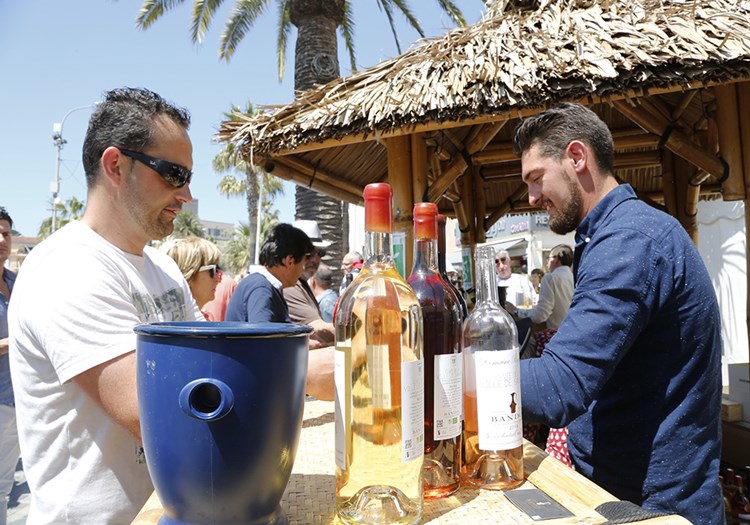
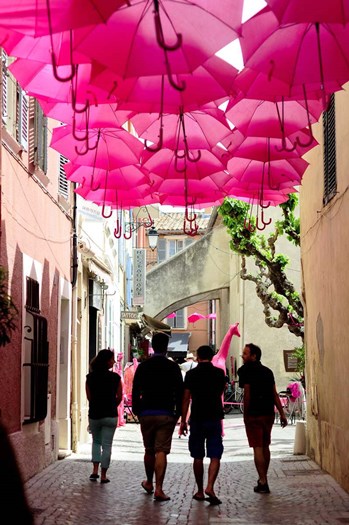
Left: The area's wine is among France's Best. Right: The streets are colourfully decorated.
Enchanted by view after breathtaking view — and remembering that Huxley took up painting when he lived here — I climb the pedestrian walkway up to Chapelle Notre-Dame-de-Pitie (1560), which offers quiet serenity far from the bustling harbour — along with sweeping views of Sanary Bay. As the sun lowers behind a mountainous limestone ridge, visitors climb aboard sailboats for sunset cruises.
Next morning, near the Town Hall, a lovely young woman passes by, her arms full of roses, on her way to the Salle de Mariage. Ah, “du nouveau monde!” the information lady exclaims when I mention Huxley’s book. But of course. I have to catch my train, but not before indulging in a port-side lunch of moules frites.
Drinking in a last view of boats, sea and sky, I am content. The pleasures of this Riviera town, where a famous writer wrote, meditated and perfected his pacifist philosophies, have opened a window onto both the man and the peaceful village where he spent some of his happiest years.
Information
Sanary-sur-Mer, one of the sunniest places in France, is 7km from the Bandol wine region, 49km from Marseilles, four hours from Paris by TGV. / The Tourism Office is at 1, Quai du Levant. A former tourism official told me, “We’ve just discovered Huxley in Sanary-sur-Mer. He was a man looking for peace, who predicted a world so close to our own.” A Huxley symposium is on the horizon; more about the town’s literary history can be found in a brochure about the German artists and intellectuals who fled to Sanary in 1933, including novelists Thomas Mann (who stayed in “my” Hotel de la Tour), Stefan Zweig, playwright Bertolt Brecht, and artistic muse and composer Alma Mahler.